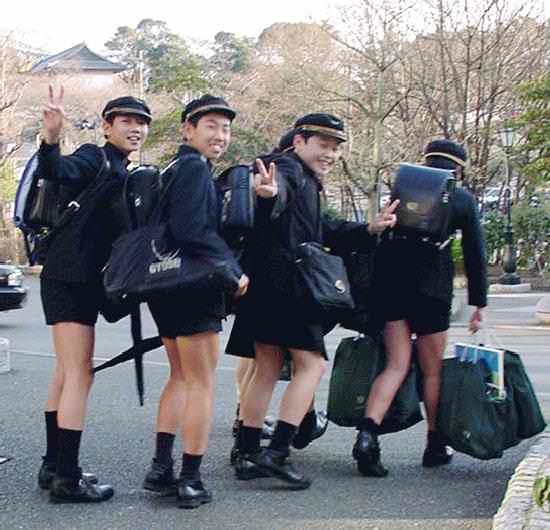
Japanese Primary School Uniform: Historical Trends--Early 21st Century

Figure 1.--These Japanese 6th graders are headed home after a hard day at school--loaded with homework. A few private schools still maintain a militart-style uniform for primary school boys. The standard public school uniform is a more civilian look.
|
We have only limited information available on Japanese school uniform trends in the 21st century. Trends in the early 21st century appear quite similar to the late 20th centurty. We have not yet noted any major new trends. Most primary schools do not require the children to wear uniforms. There are, however, quite a number of schools that do require uniforms. About a third of the schools require uniforms. These uniforms are commonly white shirts and short pants. Some school also have blazers. White kneesocks are common, but not always worn. In most cases these uniforms usually involve short pants for the boys. Few have adopted the new style of long baggy shorts. Most have short cut shorts. Some have longer, but not baggy shorts. Private schools commonly have more stringent uniform requirements. A few even have the military-styled uniforms more common in secondary schools.
Trends
We have only limited information available on Japanese school uniform trends in the 21st century. Trends in the early 21st century appear quite similar to the late 20th centurty. We have not yet noted any major new trends. We do note that a
few uniform schools permit longer shorts than were formerly the case, although the baggy style is still frowned on. Contemporary long, baggy shorts are quite commonly worn by boys at the non-uniform schools.
Uniform Policy
Non-uniform Schools
A majority of primary schools do not require the children to wear uniforms. There are, however, quite a number of schools that do require uniforms.
About a third of the schools do require uniforms. Most like the non-uniform schools require caps and there are several different styles. These uniforms are commonly simple blazers, white shirts and short pants. . White socks are common, but not always worn. Few primary schools have adopted the new style of long baggy shorts as uniforms. Most have short cut shorts. Some have longer, but not baggy shorts. The standard Japanese public primary school uniforms entails simple navy blue lapelless jacket. Usually these jackets are not absolutely required. Boys don't wear them in warm weather and some boys don't even wear them in the winter. A white short-sleeved shirt for boys and blouse for the girls is standard. Navy blue short pants (skirts for the girls) are also very common although some schools
switch to a light grey shorts (or skirts) in the summer. Some schools require white socks without patterns. Often length (ankle, mid-calf, or knee) is not specified. Commonly public schools have no sock requirement perse. Some private schools specify both sock color (including navy, black, white, or gray) and sock length (knee or ankle). Some schools do not allow overcoats even in the winter; again
some uniformed schools permit any kind of overcoat, some have a uniformed overcoat, some do not allow overcoats.
School Type
Private schools commonly have more stringent uniform requirements. A few even have the military-styled uniforms more common in secondary schools, although worn with short pants rather than long. Private schools seem much stricter about uniform requirements and despite the sea change in street fashions during the 1990s, they have not implemented significant changes in uniform policy. Tokyo
private schools all seem to require the short, trim style of short pants. The principal exception is Gakushuin (where the children of the Imperial Family attend school). They have a knee length style that dates from early in the 20th century.
Garments
Virtually all primary schools require caps--even those that have no other uniform perse and permit street clothes. The most standard cap is a kind of inverted blue sailor cap without any real brim, but there are a variety of different types. Many have elastic chin straps. Long baggy shorts have become quite common in public schools that do not
require uniforms. This reflects the general clothing trends for boys. These long, baggy shorts do not seem to be replacing short, smart shorts in the uniformed schools. A Japanese reader reports that the shorter cut shorts are still quite common in Tokyo's uniformed schools. Some boys at certain public schools wear quite long uniformed shorts (not baggy, though), but the majority still seem to wear
the traditional short, trim style in the uniformed schools.
Regional Differences
There are significant regional differences concerning schoolwear in Japan. Short pantsuniforms are even more widespread in the southern and western parts of the country. Northen Japan with much more severe winters seems to have few uniformed primary schools and those that do exist commonly permit long pants in the winter--understandable given the weather.
Conventions
Thrifty mothers at some public schools will buy their sons short pants that are several sizes too big so that they can be worn for a number of years. Younger boys can be seen practically swimming in their shorts while the older 6th graders sometimes wear very short shorts.
Christopher Wagner

Related Chronolgy Pages in the Boys' Historical Web Site
[Late 19th century]
[The 1930s]
[The 1940s]
[The 1930s]
[The 1940s]
[The 1950s]
[The 1960s]
[The 1970s]
[The 1980s]
[The 1990s]
[The 2000s]
[The 2010s]
Navigate the Boys' Historical Clothing School Uniform Pages
[Return to the Main Japanese School Uniform Early 21 Century Chronology Page]
[DWrturn to the Main Japanese School Uniform Chronology Page]
[Australia]
[England]
[France]
[Germany]
[Ireland]
[Italy]
[Japan]
[New Zealand]
[Scotland]
[United States]
Related Style Pages in the Boys' Historical Web Site
[Long pants suits]
[Short pants suits]
[Socks]
[Eton suits]
[Jacket and trousers]
[Blazer]
[School sandals]
Navigate the Boys' Historical Clothing Web Page
[Return to Main school uniform page]
[Introduction]
[Activities]
[Biographies]
[Chronology]
[Clothing styles]
[Countries]
[Bibliographies]
[Contributions]
[FAQs]
[Glossaries]
[Satellite sites]
[Tools]
[Boys' Clothing Home]
Created: April 16, 2002
Last updated: April 22, 2002



